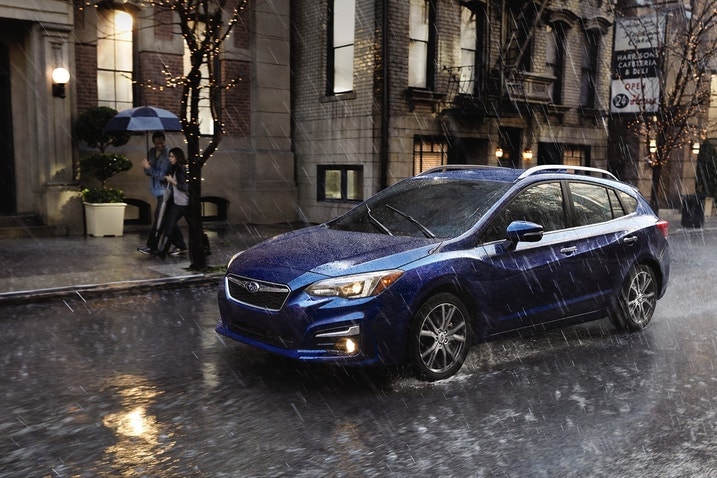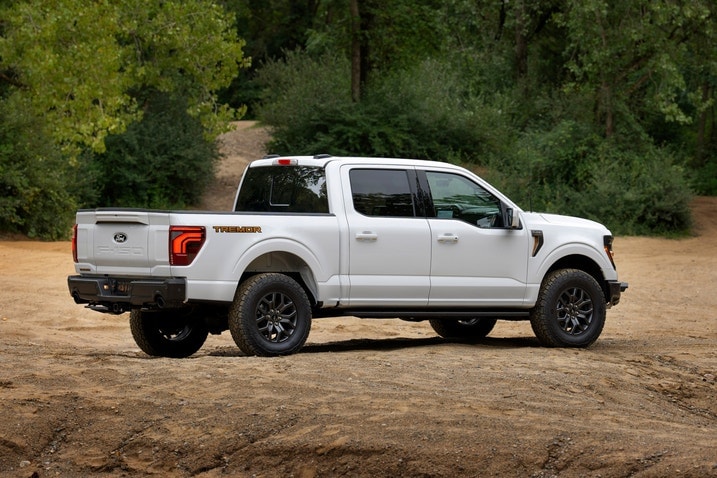All-wheel drive: A drivetrain that employs a front, rear and center differential to provide power to all four wheels of a vehicle.
Four-wheel drive: A drivetrain that employs two differentials and a transfer case to provide power to all four wheels of a vehicle.
All-wheel drive is usually only found on cars and crossovers such as the Subaru Crosstrek, Honda Passport and Hyundai Santa Cruz, while 4WD is often reserved for body-on-frame trucks, including the Ford F-150 and truck-based SUVs such as the Toyota 4Runner. There are some exceptions, like the unibody Jeep Grand Cherokee, which features a traditional 4WD transfer case.
The textbook cases
There are some cases when you should give AWD and 4WD serious consideration — for example, if you live near or spend time in places with unpaved dirt roads. Similarly, if you live in places where it rains or snows for many months out of the year, AWD or 4WD will help with traction and should be high on your list of must-have car options. However, an AWD system is always engaged. With 4WD, on the other hand, it's crucial to know when to engage the system on pavement because it can damage your vehicle and its tires.
But for some people, the choice may not be that clear-cut. Here is a list of pros and cons to help you make a better decision.
Pros of AWD/4WD
Better acceleration: An AWD or 4WD vehicle can accelerate better than a two-wheel-drive vehicle in slippery conditions. "The advantage provided by AWD is mainly in the acceleration, as the traction needs will be equally distributed among all four tires," says Cyrille Roget, a spokesperson for Michelin North America. On a car with front-wheel drive, "the need for traction will be transmitted only on two tires," adds Roget.
Helps with traction and towing: Engaging 4WD in a truck or SUV can provide enhanced traction, making it especially helpful when towing on a wet or steep boat ramp. Similarly, if you go camping off-road in dirt or sandy areas, a vehicle with AWD or 4WD will reduce your chances of getting stuck and make tackling obstacles much easier. But you don't need these systems if towing on dry, paved roads and if camping in established campgrounds is your thing.
Improves dry handling: This benefit applies only to AWD vehicles with torque vectoring. You should never engage 4WD on dry pavement as it could damage your car and tires. The AWD version of the Acura TLX is one example of a torque-vectoring system. Acura's Super Handling All Wheel Drive (SH-AWD) distributes torque to all four wheels, using a pair of electromagnetic clutches to freely regulate torque distribution between the rear wheels. This system is one of the rare cases in which AWD can help with cornering. Other performance-oriented vehicles like the Volkswagen Golf R and BMW M5 also use these kinds of AWD systems.
Added resale value: Your AWD or 4WD vehicle might be worth more if you live in an area where trucks are popular, like Texas, or in a place with harsh winters, like Colorado or Michigan. People are willing to pay a premium for vehicles with AWD and 4WD, says Richard Arca, director of vehicle valuations for Edmunds. If you look at the depreciation curve for these cars, depreciation is at its highest in the first couple of years, but then the depreciation curve begins to flatten out, and they retain their value much better than their 2WD counterparts after a few years, Arca adds. But if you live in a place with mild winters, like Florida, there will be less demand for AWD and 4WD vehicles, and buyers won't be as willing to pay as high a premium for that feature.
Cons of AWD/4WD
Added cost: The cost of an AWD or 4WD system can range from $1,500 on a Honda CR-V to about $5,000 on a Ford F-150. You'll also have to factor in slightly more for gas because the vehicle's rated fuel economy will be lower.
Lower fuel economy: AWD and 4WD system components add weight and place a higher load on the engine. These factors will decrease fuel economy by about 1-2 mpg. It may not seem like much, but this is a 5%-10% decrease in trucks (4%-9% in cars and crossovers) and can add up to a couple hundred dollars in a year.
4WD isn't meant for dry pavement: Unlike full-time AWD systems, part-time 4WD systems don't use a center differential, so the front and rear wheels can't rotate at different speeds during turns. So, using part-time 4WD on dry roads can stress the drivetrain, cause premature tire wear and negatively affect handling. It's best to engage 4WD only when road conditions require it or you're off-road.
More maintenance: The differentials on AWD and 4WD vehicles require fluid changes. And though the differential fluid doesn't need to be changed as often as the engine oil, it is an extra maintenance item to account for. It will need to be replaced about every 50,000 miles. These oil changes range from about $50 to $150 per differential. If something goes wrong with the differentials, they tend to cost more to repair than with a two-wheel-drive vehicle.
False sense of security: It is easy to be lured by an automaker's advertising and think that having AWD means you can drive in the snow or rain as easily as you would in dry conditions. But the truth is that AWD and 4WD help only with acceleration and traction. Braking distances and handling will be nearly identical to those of a two-wheel-drive vehicle. If you want better handling in the snow, consider a good set of winter tires, and even then, be sure to drive at a safe speed given road conditions.
Focus on good tires
Ultimately, your vehicle's tires can be more important than the number of wheels being driven. For example, the Audi S5 is an AWD car, but it's not a great idea to take it for a ski trip straight from the dealer's lot. That's because the S5 comes standard with summer tires that wouldn't do well in the cold. If you want optimal performance in winter weather, equip a set of winter tires on your vehicle at the end of fall and swap them back out in the spring.
Here's another way to think about it: What would perform better in the snow? A front-wheel-drive car with winter tires or an AWD car with all-season tires? Michelin tested this scenario in a study a few years ago. The FWD car with winter tires outperformed the AWD car in nearly every test. The AWD vehicle had the edge in acceleration, but when it came time to hit the brakes, its braking distance was significantly longer than that of the FWD car. Of course, if the AWD vehicle had a full set of winter tires, it would be the hands-down winner, but it goes to show the importance of good tires.
Don't buy a 10% car
People sometimes buy an AWD or 4WD vehicle for the occasional off-road outing or ski trip, while 90% of the time they'll be using the vehicle on paved roads. These drivers would be better served by renting a car for their ski trips. This route will save them money on the price of the car and in lower fuel costs.
Is AWD or 4WD worth It?
Ultimately, it comes down to what kind of conditions you’ll be driving the car in. If you live in a region that experiences unpredictable or frequent inclement weather, AWD can help you maintain better control on wet, snowy or icy roads. If you’re going to drive off-road in sand, mud and rocky terrain, a truck or SUV with 4WD will help deliver the low-range torque and enhanced traction needed to tackle more challenging environments. Understanding how and where you’ll use your vehicle is key to choosing the right drivetrain for your needs.
Wherever you end up, make sure you take the time to weigh the pros and cons and find the right car for you.

